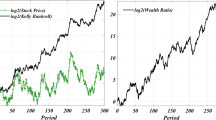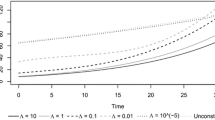Abstract
We study Markowitz’s mean-variance portfolio selection problem in a continuous-time Black–Scholes market with different borrowing and saving rates. The associated Hamilton–Jacobi–Bellman equation is fully nonlinear. Using a delicate partial differential equation and verification argument, the value function is proven to be \(C^{3,2}\) smooth. It is also shown that there are a borrowing boundary and a saving boundary which divide the entire trading area into a borrowing-money region, an all-in-stock region, and a saving-money region in ascending order. The optimal trading strategy turns out to be a mixture of continuous-time strategy (as suggested by most continuous-time models) and discontinuous-time strategy (as suggested by models with transaction costs): one should put all the wealth in the stock in the middle all-in-stock region and continuously trade it in the other two regions in a feedback form of wealth and time. It is never optimal to short sale the stock. Numerical examples are also presented to verify the theoretical results and to give more financial insights beyond them.








Similar content being viewed by others
References
Bergman, Y.: Option pricing with divergent borrowing and lending rates, Working paper, Brown University (1991)
Bielecki, T.R., Jin, H.Q., Pliska, S.R., Zhou, X.Y.: Continuous-time mean-variance portfolio selection with bankruptcy prohibition. Math. Finance 15, 213–244 (2005)
Cerny, A., Kallsen, J.: On the structure of general mean-variance hedging strategies. Ann. Probab. 35, 1479–1531 (2007)
Cerny, A., Czichowsky, C., Kallsen, J.: Numeraire-invariant quadratic hedging and mean-variance portfolio allocation, working paper, Available at https://doi.org/10.2139/ssrn.3944947 (2021)
Crandall, M.G., Lions, P.L.: Viscosity solutions of Hamilton–Jacobi equations. Trans. AMS 277, 1–42 (1983)
Cvitanic, J., Karatzas, I.: Hedging contingent claims with constrained portfolios. Ann. Appl. Probab. 3, 652–681 (1993)
Czichowsky, C., Schweizer, M.: Cone-constrained continuous-time Markowitz problems. Ann. Appl. Probab. 23, 427–857 (2013)
Dai, M., Xu, Z.Q., Zhou, X.Y.: Continuous-time Markowitz’s model with transaction costs. SIAM J. Financ. Math. 1, 96–125 (2010)
Dai, M., Yi, F.H.: Finite-horizon optimal investment with transaction costs: a parabolic double obstacle problem. J. Differ. Equ. 246, 1445–1469 (2009)
Dai, M., Yi, F.: Finite horizon optimal investment with transaction costs: a parabolic double obstacle problem. J. Differ. Equ. 246, 1445–1469 (2009)
Davis, M.H.A., Norman, A.: Portfolio selection with transaction costs. Math. Oper. Res. 15, 676–713 (1990)
Delbaen, F., Schachermayer, W.: The variance-optimal martingale measure for continuous processes. Bernoulli 81–105, 1996 (1996)
Duffie, D., Richardson, H.: Mean-variance hedging in continuous time. Ann. Appl. Probab. 1, 1–15 (1991)
Evans, L.C.: Partial Differential Equations. AMS, (2016)
Fleming, W.H., Zariphopoulou, T.: An optimal consumption and investment model with borrowing constraints. Math. Oper. Res. 16, 802–822 (1991)
Fu, C., Lari-Lavassani, A., Li, X.: Dynamic mean-variance portfolio selection with borrowing constraint. Eur. J. Oper. Res. 200, 312–319 (2010)
Gourieroux, C., Laurent, J.P., Pham, H.: Mean-variance hedging and numeraire. Math. Financ. 8, 179–200 (2002)
Guan, C.: On a free boundary problem for an optimal investment problem with different interest rates. Commun. Math. Sci. 18(1), 31–54 (2020)
Hou, D., Xu, Z.Q.: A robust Markowitz mean-variance portfolio selection model with an intractable claim. SIAM J. Financ. Math. 7, 124–151 (2016)
Hu, Y., Shi, X., Xu, Z.Q.: Constrained stochastic LQ control with regime switching and application to portfolio selection. Ann. Appl. Probab. 32, 426–460 (2022)
Hu, Y., Shi, X., Xu, Z.Q.: Constrained stochastic LQ control on infinite time horizon with regime switching. ESAIM: Control Optim. Calc. Variat. 28, 5 (2022)
Hu, Y., Zhou, X.Y.: Constrained stochastic LQ control with random coefficients, and application to portfolio selection. SIAM J. Control. Optim. 44, 444–466 (2005)
Karatzas, I., Shreve, S.E.: Methods of Mathematical Finance. Springer, Berlin (1998)
Kohlmann, M., Tang, S.: Global adapted solution of one-dimensional backward stochastic Riccati equations with application to the mean-variance hedging. Stochastic Process. Appl. 97, 255–288 (2002)
Korn, R.: Option pricing in a model with a higher interest rate for borrowing than for lending, Working paper (1992)
Luenberger, D.G.: Optimization by Vector Space Methods. Wiley, New York (1969)
Li, X., Xu, Z.Q.: Continuous-time mean-variance portfolio selection with constraints on wealth and portfolio. Oper. Res. Lett. 44, 729–736 (2016)
Li, X., Zhou, X.Y., Lim, A.E.B.: Dynamic mean-variance portfolio selection with no-shorting constraints. SIAM J. Contl. Opt. 40, 1540–1555 (2001)
Lieberman, G.M.: Second Order Parabolic Differential Equations. World Scientific, Singapore (1996)
Lim, A., Zhou, X.Y.: Mean-variance portfolio selection with random parameters in a complete market. Math. Oper. Res. 27, 101–120 (2002)
Lv, S., Wu, Z., Yu, Z.: Continuous-time mean-variance portfolio selection with random horizon in an incomplete market. Autom. 69, 176–180 (2016)
Mao, X.R.: Stochastic Differential Equations and Applications, 2nd edn. Woodhead Publishing, Sawston (2008)
Markowitz, H.M.: Portfolio selection. J. Finance 7(1), 77–91 (1952)
Markowitz, H.M.: Portfolio Selection: Efficient Diversification of Investments. Wiley, New York (1959)
Pham, H.: Continuous-Time Stochastic Control and Optimization with Financial Applications. Springer-Verlag, Berlin (2009)
Pham, H.: On quadratic hedging in continuous time. Math. Methods Oper. Res. 51, 315–339 (2000)
Richardson, H.R.: A minimum variance result in continuous trading portfolio optimization. Manage. Sci. 35, 1045–1055 (1989)
Schweizer, M.: Mean-variance hedging for general claims. Ann. Appl. Probab. 2, 171–179 (1992)
Schweizer, M.: Mean-variance hedging. Encycl. Quant. Finance (2010). https://doi.org/10.1002/9780470061602
Xia, J.: Mean-variance portfolio choice: quadratic partial hedging. Math. Finance 15, 533–538 (2005)
Xiong, J., Xu, Z.Q., Zheng, J.: Mean-variance portfolio selection under partial information with drift uncertainty. Quantit. Finance 21, 1461–1473 (2021)
Xiong, J., Zhou, X.Y.: Mean-variance portfolio selection under partial information. SIAM J. Contl. Opt. 46, 156–175 (2007)
Xu, W., Chen, S.: Optimal consumption/portfolio choice with borrowing rate higher than deposit rate. ANZIAM J. 39(4), 449–462 (1998)
Yong, J., Zhou, X.Y.: Stochastic Controls: Hamiltonian Systems and HJB Equations. Springer, New York (1999)
Yu, Z.: Continuous-time mean-variance portfolio selection with random horizon. Appl. Math. Optim. 68, 333–359 (2013)
Zhou, X.Y., Li, D.: Continuous-time mean-variance portfolio selection: a stochastic LQ framework. Appl. Math. Opt. 42, 19–33 (2000)
Zhou, X.Y., Yin, G.: Markowitz mean-variance portfolio selection with regime switching: a continuous-time model. SIAM J. Contl. Opt. 42, 1466–1482 (2003)
Acknowledgements
The authors are grateful to the editor and anonymous referees for their valuable comments and suggestions that have improved the quality of the paper. C. Guan is partially supported by NSF of Guangdong Province of China (No. 2021A1515012031 and No. 2022A1515010263) and NNSF of China (No. 11901244). X. Shi is partially supported by NSFC (No. 11801315, and No. 71871129), NSF of Shandong Province (No. ZR2018QA001), The Colleges and Universities Youth Innovation Technology Program of Shandong Province (No. 2019KJI011), Shandong University of Finance and Economics International Cooperation Research Platform. Z.Q. Xu is partially supported by NSFC (No. 11971409), The Hong Kong RGC (GRF 15202421 and 15204622), The PolyU-SDU Joint Research Centre on Financial Mathematics, The CAS AMSS-PolyU Joint Laboratory of Applied Mathematics, The Research Centre for Quantitative Finance (1-CE03), The Hong Kong Polytechnic University.
Author information
Authors and Affiliations
Corresponding author
Additional information
Communicated by Xiaoqi Yang
Publisher's Note
Springer Nature remains neutral with regard to jurisdictional claims in published maps and institutional affiliations.
Appendix: Proof of Theorem 5.1
Appendix: Proof of Theorem 5.1
In this section, we prove Theorem 5.1 by approximation method.
Firstly, for each fixed \(0<\varepsilon <1\), define a continuous function
Note that
and
so the function \(\Gamma _\varepsilon (\cdot ,\cdot )\) is Lipschitz continuous in \((-\infty ,+\infty )\times [0,+\infty ) \). Moreover, for each fixed \(c>0\), \({\partial }_\xi \Gamma _\varepsilon (\xi ,\eta )\) and \({\partial }_\eta \Gamma _\varepsilon (\xi ,\eta )\) are uniformly bounded for all \((\xi ,\eta , \varepsilon )\in (-\infty ,+\infty )\times [c,+\infty )\times [0,1]\).
Now, consider an approximation equation in a bounded domain \(Q_T^N:=(-N,N)\times [0,T]\),
The Leray-Schauder fixed point theorem (see [14] Theorem 4, p.541) and embedding theorem (see [29] Theorem 6.8) imply the existence of \(C^{1+\alpha ,\frac{1+\alpha }{2}}\big (\overline{Q_T^N}\big )\) (for some \(\alpha \in (0,1)\)) solution to the problem (54). Moreover, the Schauder estimation (see [29] Theorem 4.23) implies
In the proceeding proof, we will frequently use the following fact without claim:
We first establish the estimates
Denote
Using the definitions of \(\theta _2\), \(a_1\) and \(a_2\) as well as the bounds on A and \(A'\), we get
Notice \(\theta _1>\theta _2\), so
Applying the comparison principle for linear equations, the first inequality in (55) is established.
Similarly, let
Then by the definitions of \(\theta _1\), \(a_1\) and \(a_2\),
Moreover,
by the comparison principle, the second inequality in (55) is established.
Due to the setting of boundary conditions, we cannot establish \(w^{\varepsilon ,N}_z\ge \frac{1}{2}e^{-\kappa s} e^z\). Instead, we first prove
where
Differentiating the equation in (54) w.r.t. z we have
After reorganizing, we get an equation for \(w^{\varepsilon ,N}_z\) in the divergence form:
It is not hard to check that all the coefficients in (57) are bounded. Denote \(\psi (z,s)=-e^{-\theta _3 s} d\), then
thanks to the definition of \(\theta _3\). Moreover,
Using the comparison principle for divergence forms (see [29] Corollary 6.16), we obtain \(w^{\varepsilon ,N}_z\ge \psi \), giving (56).
We next to prove
Denote \(g^{\varepsilon ,N}(z,s)=e^{-z}w^{\varepsilon ,N}_z(z,s)\). According to (57), we have
On the other hand, denote \(\Psi (z,s)=\frac{1}{2}e^{k s}\), then
thanks to the definition of k. Notice \(k\ge \theta _1\), so
Using the comparison principle for divergence forms, we obtain \(g^{\varepsilon ,N}\le \Psi \), proving (58).
Thanks to (55), (56) and (58), for each \(a<b\), when \(N>\max \{|a|,|b|\}\), taking the \(C^{\alpha ,\frac{\alpha }{2}}\) interior estimate (see [29] Theorem 6.33) to the equations in (54) and (57) respectively, we obtain
where C is independent of \(\varepsilon \) and N. Since \(\Gamma _\varepsilon (\cdot ,\cdot )\) is Lipschitz continuous in \((-\infty ,+\infty )\times [0,+\infty ) \), we have
i.e. the coefficients in the equation of (54) belong to \(C^{\alpha ,\frac{\alpha }{2}}([a,b]\times [0,T])\), so we can take the Schauder interior estimate to the equation in (54) to get
where the above two \(C_\varepsilon \)s are independent of N. Therefore, there exists \(w^\varepsilon \in C^{2+\alpha ,1+\frac{\alpha }{2}}\big (\overline{Q_T}\big )\) such that, for any region \(Q=(a,b)\times (0,T]\subset Q_T\), there exists a subsequence of \(w^{\varepsilon ,N}\), which we still denote by \(w^{\varepsilon ,N}\), such that \(w^{\varepsilon ,N}\rightarrow w^\varepsilon \) in \(C^{2,1}(\overline{Q})\) when \(N\rightarrow \infty \). So \(w^\varepsilon \) satisfies the initial problem
The exponential growth conditions on \(w^\varepsilon \) and \(w^\varepsilon _z\) come from the estimates (55), (56) and (58).
We now prove
Denote
Letting \(N\rightarrow \infty \) in (59), we obtain
On the other hand, denote \(\Psi (z,s)=\frac{1}{2}e^{-\kappa s}\), we have
thanks to the definition of \(\kappa \). Moreover, \(g(z,0)=\frac{1}{2}=\Psi (z,0)\). By the comparison principle, we have \(g\ge \Psi \); hence, (63) is proved.
Thanks to (58) and (63), \(w^\varepsilon _z\) has positive lower and upper bounds which are independent of \(\varepsilon \) in any bounded region, noting that the bounds of \(|{\partial }_\eta \Gamma _\varepsilon (\xi ,\eta )|\) and \(|{\partial }_\eta \Gamma _\varepsilon (\xi ,\eta )|\) are independent of \(\varepsilon \) when \(\eta \) has a positive lower bound, so the constants \(C_\varepsilon \)s in the estimates (60) and (61) are independent of \(\varepsilon \). Let \(\varepsilon \rightarrow 0\) in (62), we obtain a limit w that satisfies (17). Moreover, (18) and (19) are the direct consequences of (55), (58), (63).
Rights and permissions
Springer Nature or its licensor (e.g. a society or other partner) holds exclusive rights to this article under a publishing agreement with the author(s) or other rightsholder(s); author self-archiving of the accepted manuscript version of this article is solely governed by the terms of such publishing agreement and applicable law.
About this article
Cite this article
Guan, C., Shi, X. & Xu, Z.Q. Continuous-Time Markowitz’s Mean-Variance Model Under Different Borrowing and Saving Rates. J Optim Theory Appl 199, 167–208 (2023). https://doi.org/10.1007/s10957-023-02259-4
Received:
Accepted:
Published:
Issue Date:
DOI: https://doi.org/10.1007/s10957-023-02259-4
Keywords
- Markowitz’s mean-variance portfolio selection
- Fully nonlinear PDE
- Free boundary
- Dual transformation
- Different borrowing and saving rates




